Master Clam Chowder: The Ultimate Culinary Guide
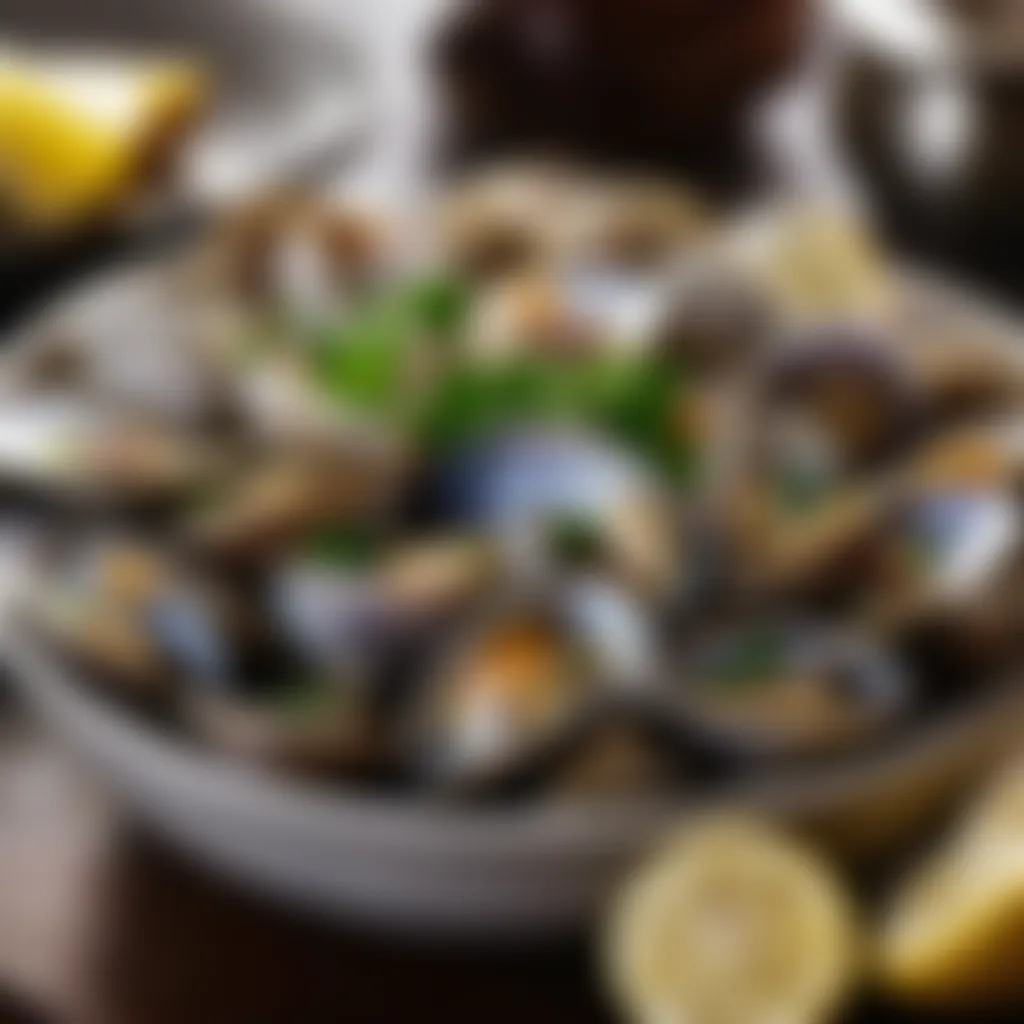
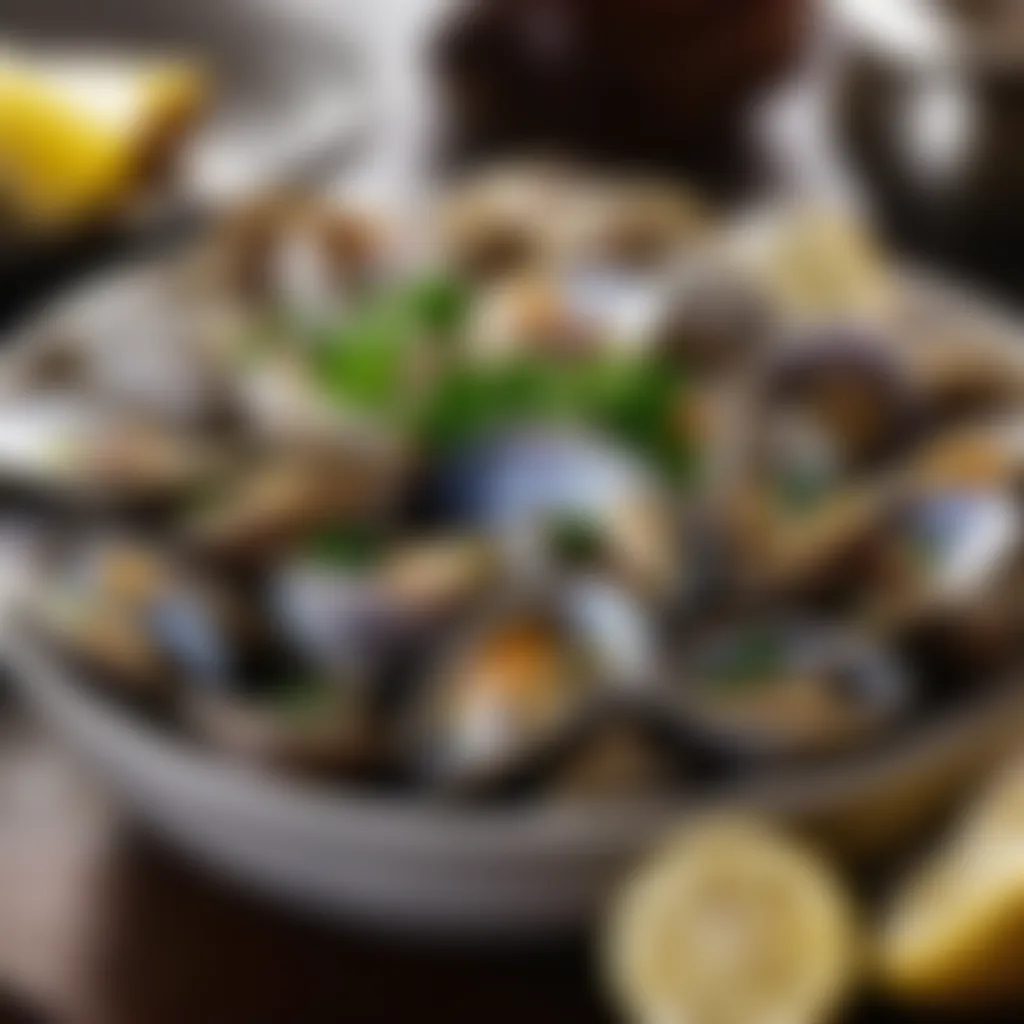
Intro
Clam chowder is more than just a dish; it’s a culinary tradition that warms hearts and fills bellies. Steeped in history, this creamy delight has roots reaching back to the shores of New England and has evolved into numerous regional variations. It’s a comfort food staple that reigns supreme in many kitchens, yet mastering it can feel like navigating a tightrope. Fear not, for this guide seeks to provide a comprehensive pathway from the initial gathering of ingredients to the final tasting of this classic dish.
Understanding clam chowder means delving into its essential components—ingredients that not just define it, but also influence the flavors and textures for which it’s known. Together, we will explore the key techniques behind each preparation step, ensuring that you’re equipped with the knowledge to elevate your chowder from simple to superb. So if you’re a housewife looking to impress family or simply increase your culinary repertoire, this article is your trusted companion.
Ingredients:
To create a sumptuous clam chowder, you need to gather the following ingredients. Having everything prepped before you start cooking makes for a smoother experience.
- Clams (fresh or canned): 2 dozen fresh clams (or two 10-ounce cans of chopped clams with juice)
- Bacon: 4 slices, chopped (smoked bacon adds depth)
- Butter: 4 tablespoons
- Onion: 1 medium, finely chopped
- Celery: 1 stalk, finely chopped
- Garlic: 2 cloves, minced
- Flour: 1/3 cup (for thickening)
- Potatoes: 2 medium, peeled and diced
- Chicken broth: 2 cups
- Heavy cream: 1 cup
- Bay leaves: 2
- Thyme: 1 teaspoon (dried or fresh)
- Salt and pepper: to taste
All these components come together to provide the base for a flavorful experience, reflecting the essence of clam chowder.
Detailed Instructions:
Now let’s breakdown the preparation process into clear and manageable steps:
- Prepare the clams: If using fresh clams, rinse them thoroughly under cold water to remove any sand. Steam them in a pot with a bit of water until opened, then set aside. Reserve the broth.
- Cook the bacon: In a large pot, cook the chopped bacon over medium heat until crispy. This may take about 5-7 minutes. Remove the bacon and drain on paper towels, leaving the rendered fat in the pot.
- Sauté vegetables: Add butter to the bacon fat and melt it. Then, throw in the chopped onion, celery, and garlic. Cook until the onion becomes translucent, roughly 3-5 minutes.
- Add flour: Sprinkle the flour over the sautéed vegetables and mix well. Cook for an additional 2 minutes to remove the raw flour taste.
- Incorporate broth and potatoes: Gradually pour in the chicken broth and reserved clam broth. Once combined, toss in the diced potatoes and bay leaves. Bring to a simmer and let cook until the potatoes are tender, about 15-20 minutes.
- Finish with cream and clams: Lower the heat and add the heavy cream, stirring continuously. Mix in the clams, bacon, thyme, and season with salt and pepper to taste. Allow it to warm through for about 5 minutes.
- Serve: Discard the bay leaves and ladle the chowder into bowls. You can garnish with fresh parsley for added color.
Technical Aspects:
When cooking clam chowder, attention to detail is essential for achieving that perfect blend of flavors. Maintain a gentle simmer instead of boiling—this ensures that the cream doesn’t separate and the clams don’t become rubbery.
- Temperature settings: Medium heat is your friend; it allows the fat and flavors to meld together beautifully.
- Timing specifics: Pay attention to the doneness of the potatoes—overcooked potatoes can break down and turn to mush.
Cooking Process:
Now that you have outlined your ingredients and preparation steps, let's tackle the cooking process sequentially:
- Bacon rendering: First, render the bacon fat; it's crucial to get that foundational salty flavor.
- Sauté until soft: Properly sautéing your vegetables brings out their natural sweetness—don’t rush this step.
- Thicken at the right time: Adding flour right after the vegetables ensures a smooth, lump-free chowder.
Troubleshooting Tips:
Like any art, cooking clam chowder can throw a curveball every now and then. Here are a few solutions to common challenges:
- Too thick? Add a splash of additional broth or cream.
- Too thin? Simmer longer to allow it to reduce, or stir in a slurry of flour and water to thicken quickly.
- Flavor lacking? A dash of Worcestershire sauce or even hot sauce can bring a punch, while fresh herbs can brighten the overall taste.
Remember, practice makes perfect. With each attempt, you’ll refine your technique and expand your culinary repertoire.
As we move forward in the article, we will continue to delve deeper into the history, variations, and intricacies that make clam chowder a beloved dish around the world. \
Prelims to Clam Chowder
Clam chowder, a dish that has graced tables for centuries, is about more than just food; it’s a tradition steeped in history. It's more than a hearty meal on a chilly day; it represents a culinary journey that connects regional flavors and cultures. This guide sets the stage for a deep dive into clam chowder. Understanding its roots, its varieties, and its significance can elevate one’s cooking to another level, transforming a basic recipe into a heartfelt creation. Not only do we explore the history, but we also venture into the core ingredients, preparation processes, and techniques necessary for perfecting this beloved dish.
Historical Significance
The origins of clam chowder are a tapestry of cultural influences. Dating back to the early settlers in the New England area, the dish's journey began with the Native Americans’ use of local clams and indigenous herbs. By the 18th century, Europeans had made clam chowder a staple—adapting it to blend with familiar ingredients like salt pork and root vegetables. The most notable transformation occurred when the creamy, rich variety emerged, forever changing how people perceived chowder.
Additionally, many believe that the word "chowder" itself comes from the French word "chaudière," referring to a cooking pot. As fishermen prepared their meals, they would throw what they had into one pot, creating a stew-like dish that eventually evolved into the chowder we enjoy today. This understanding of origins provides a deep appreciation for each bowl served. Clam chowder is not merely a recipe; it’s a rich history served warm on a plate.
Cultural Variations
Clam chowder is not confined to New England; it’s a dish that has adapted beautifully across varying cultures and regions.
- New England Clam Chowder: The classic creamy chowder that many are familiar with. Loaded with potatoes and often featuring a smoky flavor from the addition of salt pork or bacon.
- Manhattan Clam Chowder: A tomato-based version that brings a colorful twist to the traditional cream-based soup. It showcases how regional tastes can drastically change a dish's identity.
- Rhode Island Clam Chowder: Offering a clear broth version, this variation enables the natural flavor of the clams to shine through without the heaviness of cream.
Each version tells a story of the local ingredients and preferences that shape its character. A bowl of clam chowder can act as an edible map of culinary traditions, reflecting the unique palette of its origin and the souls who savor it. By embracing these variations, one can appreciate the myriad ways this dish connected communities and developed an everlasting legacy as a comfort food.
Understanding Clam Chowder Ingredients
The ingredients of clam chowder are the heartbeat of this beloved dish. Understanding these elements is pivotal to mastering it. Each ingredient brings its unique flair, contributing to the overall flavor and texture of the chowder. It's not just about throwing a bunch of things into a pot; it’s about knowing how each component works together to create harmony in your bowl.
Types of Clams
When it comes to clams, not all are created equal. In clam chowder, the type of clam can greatly influence the taste and texture of the final product. You might find quahogs, cherrystones, or little neck clams being used in various recipes.
- Quahogs – Known for their robust flavor, these are often used in the traditional chowders of New England. Their meat is firm, providing a hearty bite that's hard to resist.
- Cherrystones – A bit sweeter than their quahog cousins, these clams can add a delicate touch to the dish with their slightly chewy texture.
- Little Necks – These smaller clams are prized for their tender, mild meat. They are often reserved for eating raw but can shine brilliantly in chowder as well.
Choosing wisely here can make or break your chowder.
Essential Aromatics
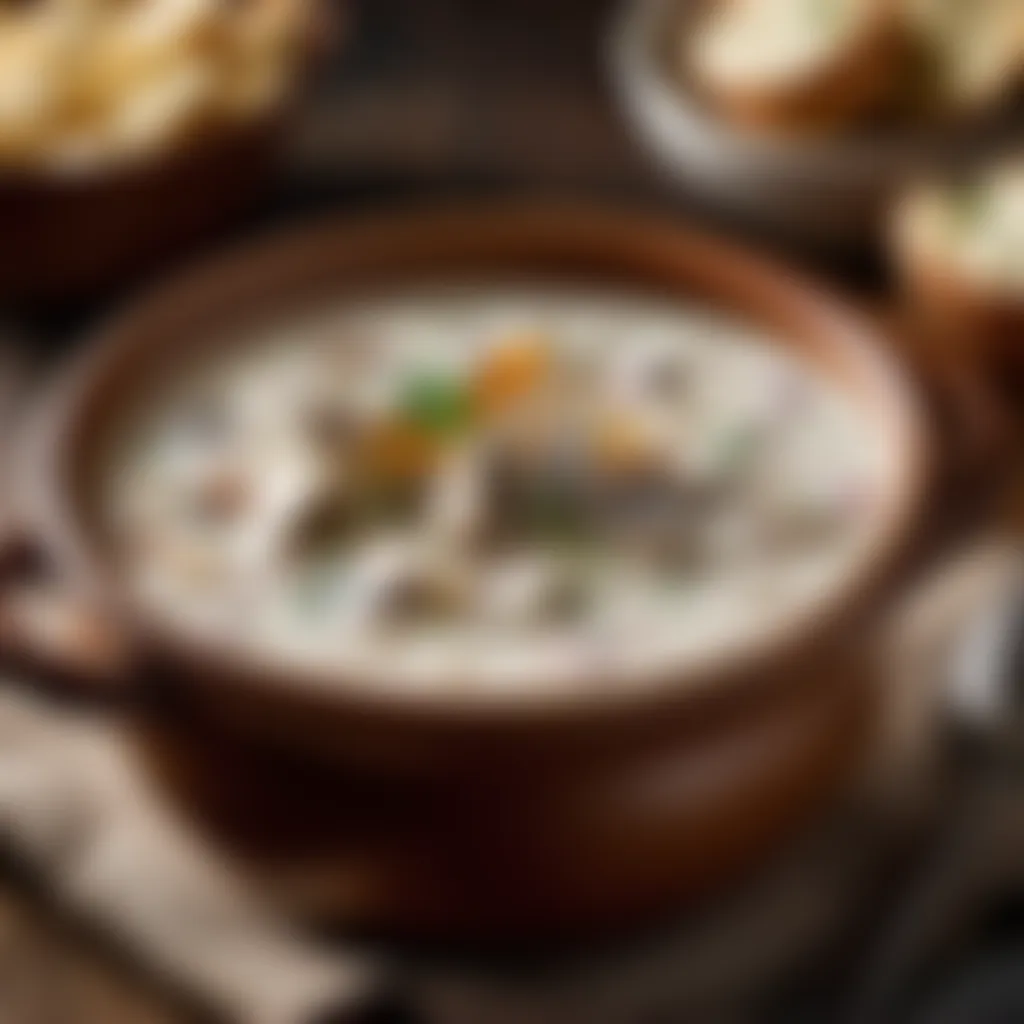
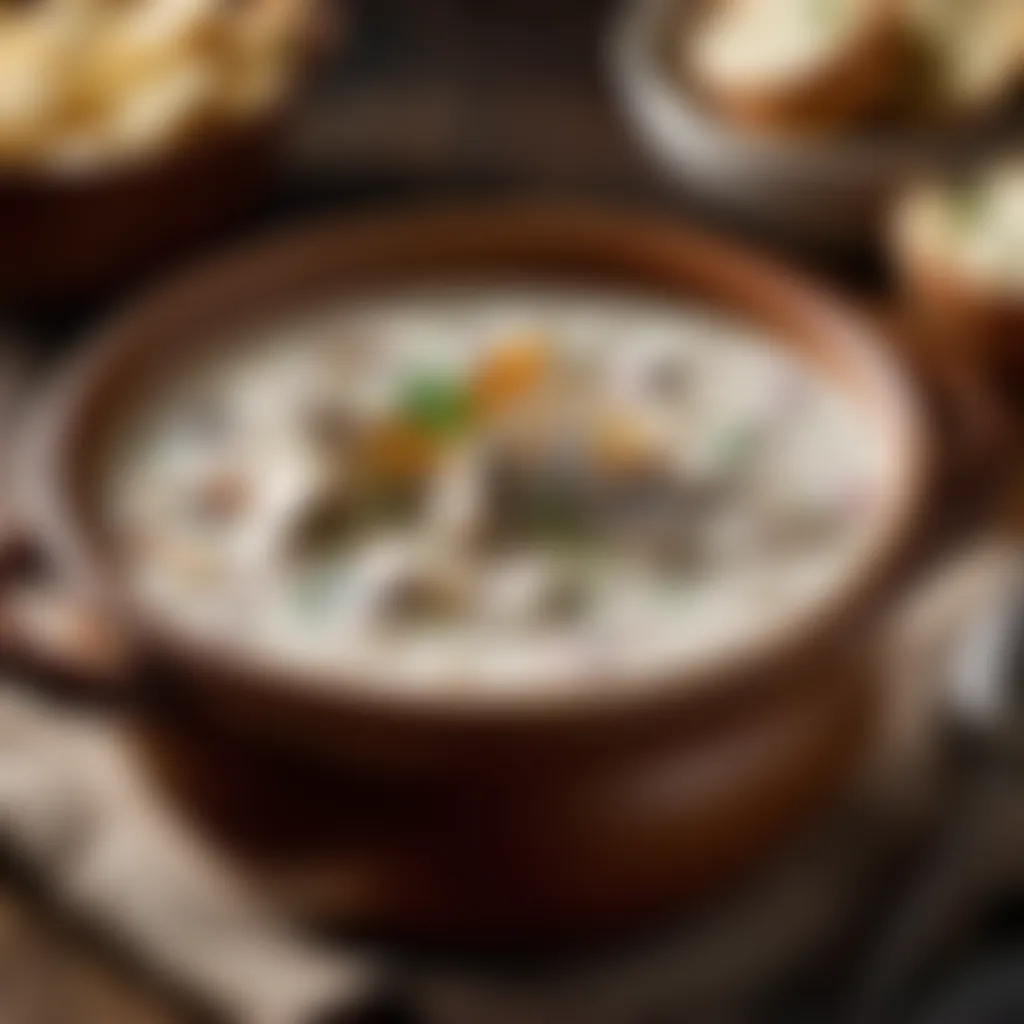
Next up are the aromatics – often the unsung heroes of chowder making. A good aromatic base can elevate your chowder from bland to grand. Onion, garlic, celery, and thyme are common choices:
- Onion – Provides a sweet, sturdy foundation. Consider using yellow or sweet onions for a hint of sweetness that blends beautifully with the briny clams.
- Garlic – One clove or two can add depth and warmth, enhancing the overall taste without overpowering the dish.
- Celery – Adds crunch and a subtle earthiness that balances the creamy aspects of chowder.
- Thyme – A sprinkle of fresh or dried thyme lends an herbaceous note, complementing the clams splendidly.
The trick is to sauté these aromatics at the right stage, allowing the flavors to develop while keeping them fresh.
Broth Base
Clearly, the broth base is the soul of clam chowder. When you consider your options, think about whether you want a clear broth, a white cream base, or something richer. Traditionally, clam chowder is known for its creamy consistency. The base can be made from:
- Clam juice – Using the liquid harvested while steaming clams is a fantastic way to inject flavor right at the core of your chowder.
- Fish stock – Some choose to incorporate fish stock to enhance that maritime flavor profile.
- Vegetable broth – This can be a great option, particularly for those seeking healthier alternatives or vegetarian options.
Each choice lays the foundation for flavor depth in your chowder, so choose wisely.
Cream vs. Milk: A Comparison
Finally, we arrive at an age-old question: cream or milk? This decision can affect the richness and texture of your chowder.
- Cream – If you desire a luscious, velvety finish, cream takes the lead. It offers a thicker, more indulgent texture, making each spoonful a joy.
- Milk – For a lighter option, whole milk can work fine, yielding a thinner consistency. This can be appealing if you aim for a chowder that feels less heavy.
Keep in mind that the choice between cream and milk could also depend on dietary considerations and personal preference. Some folks even go half and half for a balanced approach, creating a chowder that’s both creamy and not too rich.
Understanding these ingredients is essential for creating a clam chowder that not only delights the palate but also pays homage to its roots.
By grasping the nuances of these ingredients, you’re not just following a recipe, you’re embarking on a culinary journey. That's the essence of mastering clam chowder; knowing your ingredients inside and out informs your cooking and enhances your final results.
The Preparation Process
The preparation process is a fundamental aspect of crafting a delicious clam chowder. It lays the groundwork for flavor, texture, and overall experience in the final dish. Understanding this phase allows a cook to make informed choices, ensuring every bowl served is a masterpiece of culinary art. The precision in prepping not only enhances the dish's complexity but also highlights the chef’s commitment to quality.
Gathering Ingredients
Gathering the right ingredients is the first step in making clam chowder. It may seem trivial, but this is where the culinary journey begins. A fresh, quality component list doesn’t just elevate flavor but also contributes to the dish's authenticity. Here’s what you'll need:
- Clams (like cherrystones or quahogs)
- Potatoes (Yukon Gold works well)
- Onions and celery
- Fresh thyme or bay leaves
- Butter and flour for a roux
- Milk and heavy cream
Choosing fresh clams is vital. A tip: if you can smell them before cooking, they might not be worth it. Look for closed shells, signaling freshness. It’s equally important to opt for seasonal veggies, which can make your chowder stand out in a crowd.
Prepping the Clams
Once the clams are gathered, proper preparation is the next step. Start by cleaning them thoroughly under running water to eliminate any sand or grit. A good rule of thumb is to soak the clams in salted water for about 30 minutes. This allows them to expel any remaining grit. After that, scrub the shells gently with a brush. Remember, a clean clam is a happy clam, and it makes for a better eating experience.
You also have a choice between using fresh clams or canned options. Fresh will provide a more robust flavor, while canned can save time. If you choose canned clams, make sure to include some juice in your mixture to enhance that clam flavor.
Building the Base
Building a solid base is essential for a rich, satisfying chowder. Begin by making a mirepoix with diced onions, celery, and carrots. Sautéing this mix in butter releases the vegetables' natural sweetness. Allow them to soft for about five minutes before adding flour to create a roux. This step thickens the chowder and gives it a velvety texture.
After stirring in flour, gradually add your broth. Chicken broth or seafood broth could work, but clam juice is often the best choice here. It will kick off the flavor profile, marrying beautifully with the clams and other ingredients. Let it simmer gently before adding potatoes, which build heartiness.
Incorporating Creaminess
The final piece of this puzzle is adding the creaminess that makes clam chowder so comforting. After your base has simmered and the potatoes are tender, slowly stir in heavy cream and milk. Opt for heavy cream if you desire a thicker consistency; for a lighter chowder, stick with half-and-half or milk.
Watch the pot closely during this phase. Allowing the chowder to boil after adding cream can curdle it, ruining its smooth texture. Instead, use low heat to reach the ideal creamy state.
Incorporating seasoning at this stage is crucial. Salt and black pepper are staples, but feel free to throw in some Worcestershire sauce or hot sauce for extra depth. A finished chowder should be perfectly balanced, showcasing both the delicate clam flavor and the creaminess that wraps around every bite.
"Every detail counts when making clam chowder; from gathering ingredients to the texture of the final dish, each step builds towards the perfect bowl."
By grasping the significance of the preparation process, you set yourself up for success, allowing the flavors to shine through as they come together harmoniously.
Cooking Techniques for Perfection
When it comes to creating a simple yet flavorful clam chowder, the cooking techniques employed can make all the difference. Mastering these techniques is what elevates a good clam chowder into a truly memorable one. Every chef, whether novice or seasoned, can benefit from understanding the nuances behind these methods. By honing your skills in simmering, flavor layering, and temperature control, you'll be brewing a bowl of clam chowder that not only satisfies but also impresses those around your dining table.
Simmering vs. Boiling
At first glance, simmering and boiling may seem like two sides of the same coin, but they are worlds apart when it comes to cooking clam chowder efficiently. Boiling is the fierce dance of bubbles, where water reaches a rolling state, often leading to turbulent movements that can break delicate ingredients apart. This method may compromise the texture of the clams and other components, resulting in a dish that lacks finesse.
On the other hand, simmering is where magic really happens. Doing this technique means cooking at a lower, gentler heat, just under the boiling point. It allows flavors to meld without causing the ingredients to disintegrate.
"A good chowder is born from gentle heat and patient simmering."
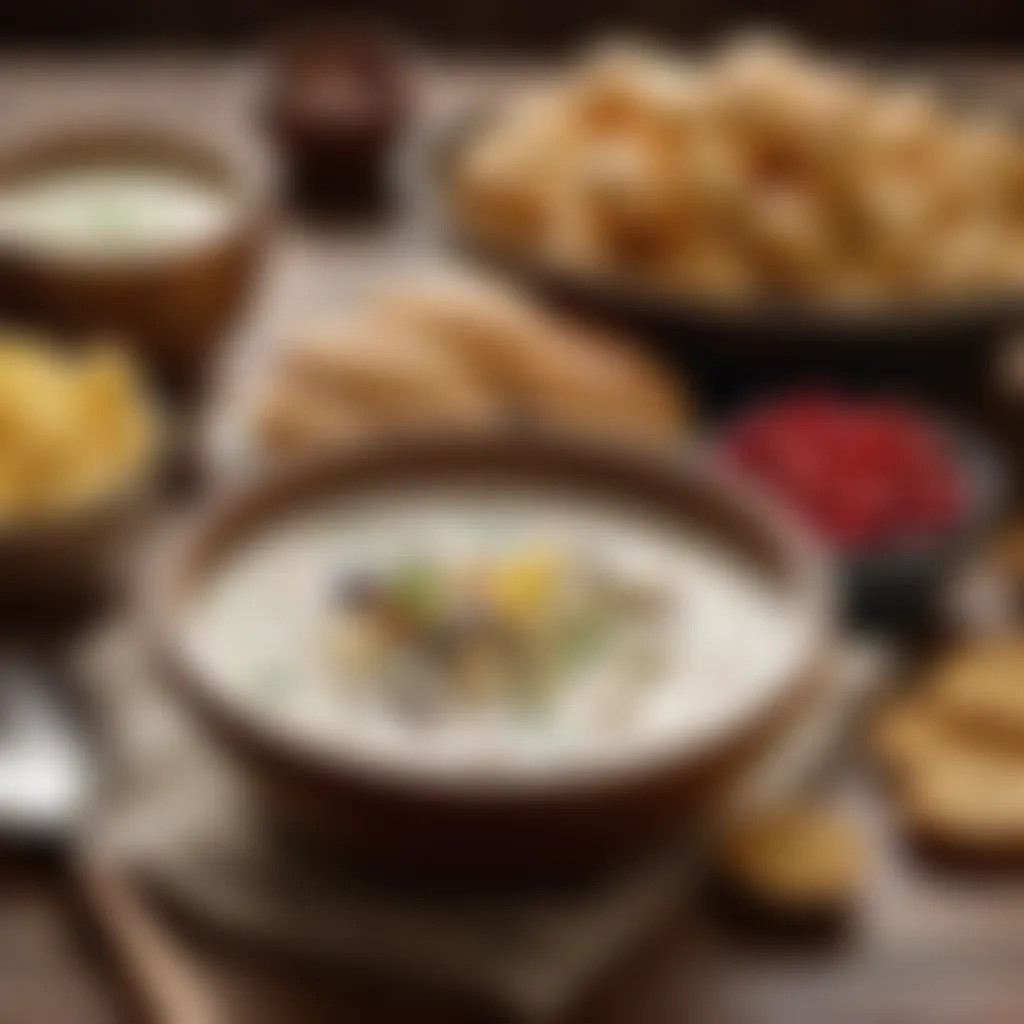
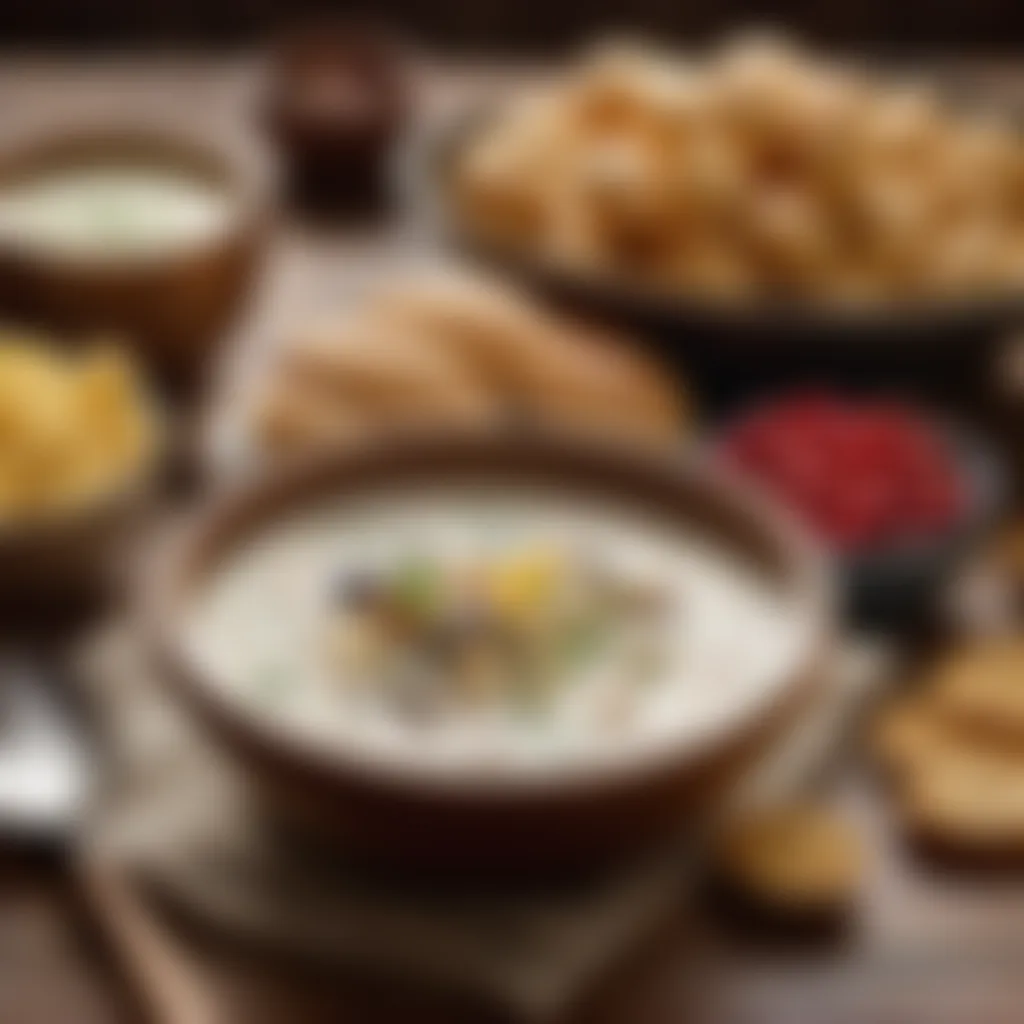
A hint for those in the kitchen: let your chowder rest on a low flame and embrace the soft bubbling. Not only will this develop deeper flavors, but it also ensures that every last clam remains succulent. Consider trying this method on your next batch, keeping a close eye on it, as patience here is certainly a virtue.
Layering Flavors
Layering flavors is akin to building a beautiful architectural structure, where each layer is essential to the overall aesthetic and strength. This practice is essential in crafting a clam chowder that intrigues the palate. Start with a flavor base by sautéing your aromatics, such as onions, garlic, and celery, in butter. The act of sweating those ingredients allows their sugars to caramelize and enhances the sweet essence found in every bite.
Once the foundation is set, gradually introduce your broth and cream, allowing them to interact with the earlier layers. This additional component infuses complexity and richness, leaving your chowder bursting with flavor.
To really fine-tune your layering, don't shy away from spices and herbs like thyme, bay leaf, or even a twist of smoky paprika. Each addition builds on the previous one, creating an intricate tapestry of taste that will grab hold of anyone fortunate enough to partake in your culinary creation. Remember, balancing flavors is key; sometimes a squeeze of lemon can serve as the finishing touch, brightening the whole dish while livening up your taste buds.
Temperature Control
Temperature control is more than just a culinary term; it’s the conductor of your kitchen symphony. Knowing when to adjust your heat allows for a proper cooking environment, ensuring that your chowder turns out creamy and delightful rather than lumpy and overcooked.
During the cooking process, you’ll need to be mindful of how different temperatures affect your ingredients. High heat can cook clams and potatoes unevenly, while too low may result in a chowder that takes forever to reach the desired thickness. A middle ground must be struck; your chowder needs to reach a safe simmer that encourages texture to bloom, but without hanging at extremes.
Alternatively, as you finish your chowder, cooling times and reheating methods also warrant attention. Bringing your chowder reheated slowly ensures it doesn’t separate or form an unwanted skin on top.
In summary, controlling temperature and adjusting as needed, when mixing and serving, will not only enhance the taste of your chowder but also improve your confidence as a chef.
By becoming adept in these cooking techniques, your journey towards clam chowder mastery evolves into an enjoyable culinary adventure, full of discovery and growth.
Modern Adaptations of Clam Chowder
In today’s culinary landscape, where fresh ingredients and dietary preferences are prominent, modern adaptations of clam chowder play a crucial role in preserving the dish's relevance. Traditional recipes provide the foundation, steeped in history, yet being adaptable allows for innovation without losing the essence of clam chowder. By reinterpreting this classic dish, cooks can cater to diverse preferences and health consciousness, thus ensuring that clam chowder features prominently on the table for all sorts of diners.
One important aspect to consider when diving into these adaptations is taste — it must remain at the forefront. Using high-quality ingredients and exploring new flavor profiles can elevate the dish. It also reflects a broader culinary trend: the shift toward healthier eating habits without sacrificing flavor or comfort.
Healthy Alternatives
Looking to enjoy clam chowder while being mindful of health? There are numerous healthy alternatives that can be employed in the culinary process.
- Whole Grains: Instead of using refined flour, opt for whole grain alternatives or even gluten-free options like chickpea flour to thicken your chowder. This swap not only enhances the nutritional value but also offers additional fiber.
- Lower-Fat Dairy: Consider substituting heavy cream with Greek yogurt or low-fat sour cream. These options still bring creaminess to the dish while reducing calorie intake.
- Vegetable Broth: A shift from clam or chicken broth to a robust vegetable broth can impart rich umami flavors with fewer calories and sodium, making the dish lighter overall.
- Add Greens: Think outside the box by tossing in some fresh spinach or kale, which can not only boost the nutritional profile but also add a colorful and appealing look to your chowder.
Such creative substitutions maintain the comforting qualities of clam chowder while promoting a healthier meal choice.
Vegetarian and Vegan Options
For those leaning toward vegetarian or vegan lifestyles, clam chowder can undergo significant transformation without losing its charm. While the original recipe famously uses clams as the star, there are alternate paths one can take to craft something equally comforting.
To create a vegetarian version, simply omit the clams but keep the essential base intact. Here’s how:
- Mushrooms: Substitute clams with diced mushrooms, particularly varieties like shiitake or oyster, which can provide a similar flavor profile and texture.
- Seaweed: Incorporating kitchen staples like nori or dulse can mimic the oceanic flavors typically associated with clams.
- Vegetables: Load up the chowder with a medley of vegetables - think corn, potatoes, and even carrots, boosting both health and flavor.
For true vegan adaptations, adhere to the following tips:
- Plant-based Creams: Instead of cream, consider using coconut cream or cashew cream for a dairy-free richness. This can add a delightful twist in flavor too.
- Nutritional Yeast: This ingredient works wonders to bring that cheesy, savory flavor that might be missed in a vegan option.
- Activated Nuts: Adding activated hemp seeds can add texture, protein, and a nutty flavor that rounds out the dish beautifully.
By integrating these thoughtful adaptations, you ensure that clam chowder remains inclusive for all palates and dietary needs.
In the end, the art of clam chowder transcends traditional boundaries, allowing for great flexibility while remaining rooted in rich flavors. By embracing modern adaptations, not only can chefs innovate, but they can also connect with a wider audience, ensuring that everyone can appreciate a good bowl of chowder — whether they're health-conscious, vegetarian, or vegan.
Serving Suggestions
When it comes to clam chowder, serving suggestions can turn a simple bowl of soup into a memorable culinary experience. The right accompaniments and presentation not only enhance the flavors of the chowder itself but also elevate the entire eating experience. There’s an element of creativity involved that allows each housewife to express her unique style, making every serving a personal touch. This section will delve into those crucial elements, offering insights and tips for serving your clam chowder in the best possible manner.
Accompaniments to Enhance Flavor
Selecting the right accompaniments can make all the difference in a clam chowder meal. Here are a few suggestions to consider:
- Bread: Freshly baked bread, like a sourdough or crusty baguette, can be a fantastic pair. It serves not only to soak up the rich broth but adds a delightful texture and warmth to the meal.
- Crackers: Oyster crackers or buttery saltines are a classic choice, providing that crunchy contrast to the creamy chowder.
- Herbs and Spices: Topping your chowder with some freshly chopped chives, a sprig of parsley, or even a pinch of Old Bay seasoning can elevate the dish. Each adds fresh aroma and extra layers of taste.
- Cheese: A sprinkle of grated Parmesan or a dollop of cream cheese can introduce a new dimension to the flavor palette.
- Acid: A squeeze of lemon or a dash of vinegar can brighten the richness of the chowder, giving it a refreshing zing that balances the savory notes.
Adapting the accompaniments to individual tastes and regional influences can create a unique take on this classic dish.
Presentation Techniques
How you present clam chowder can say as much as the flavors you’ve crafted in the pot. Consider these techniques to impress your guests:
- Serving Dishes: Opt for visually appealing bowls. A wide, shallow bowl allows for a more elegant presentation, while a rustic soup pot can evoke a cozy, homey feel.
- Garnishes: Use garnishes creatively. A swirl of cream or a sprinkle of paprika can turn a simple bowl into a work of art. Remember, presentation is all about adding that touch of finesse.
- Color Contrast: Serve your chowder alongside vibrant sides such as a colorful salad or even a medley of pickled vegetables. The eye is drawn to colors, and a splash of greens or reds can enhance the dining experience.
- Temperature: Serve the chowder hot and pair it with warm bread or crackers. The contrast between the warmth of the dish and the coolness of accompaniments like a salad can be delightful.
"Food is much more than the sum of its parts – it's nostalgia, experience, and artistry on a plate."
By carefully considering your accompaniments and presentation techniques, you ensure that your clam chowder doesn’t just satisfy hunger but also delights the senses. Whenever you set the table, remember it's not just a meal; it's an experience to savor.
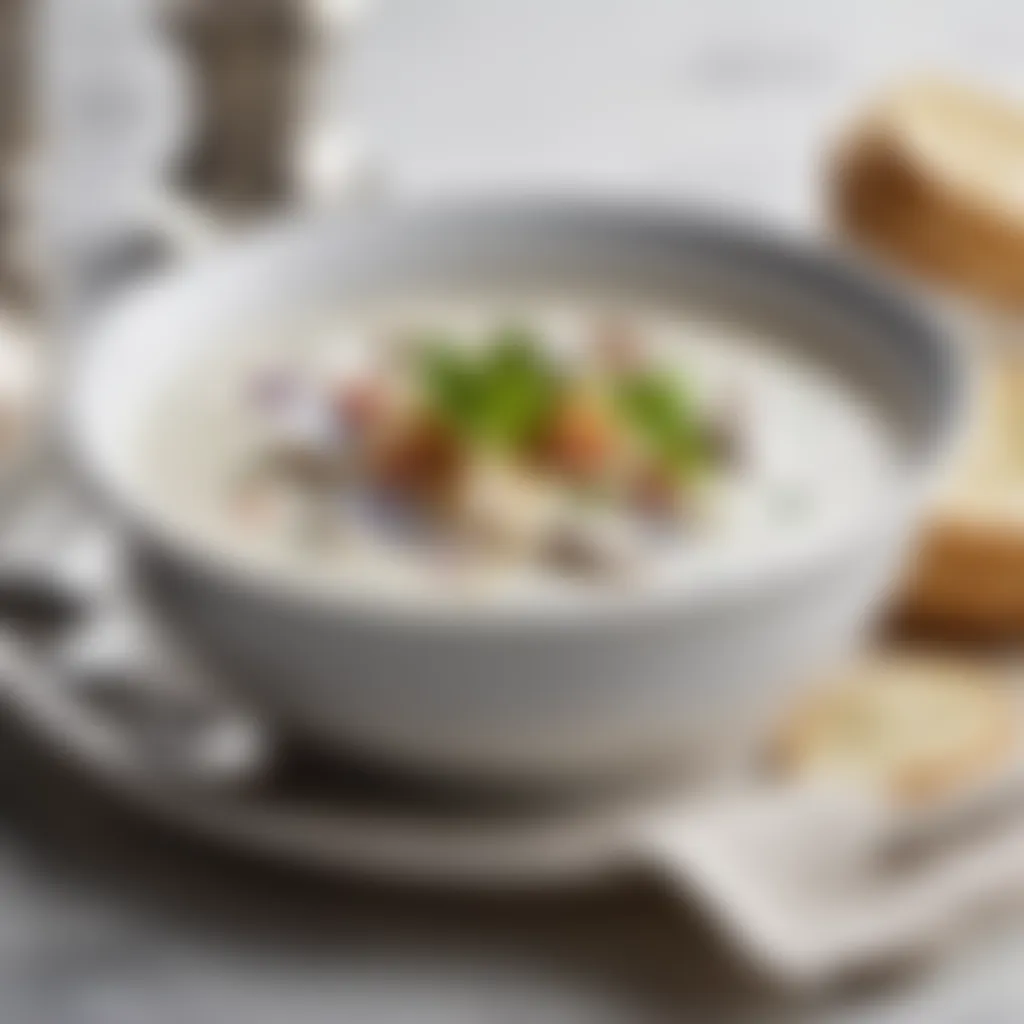
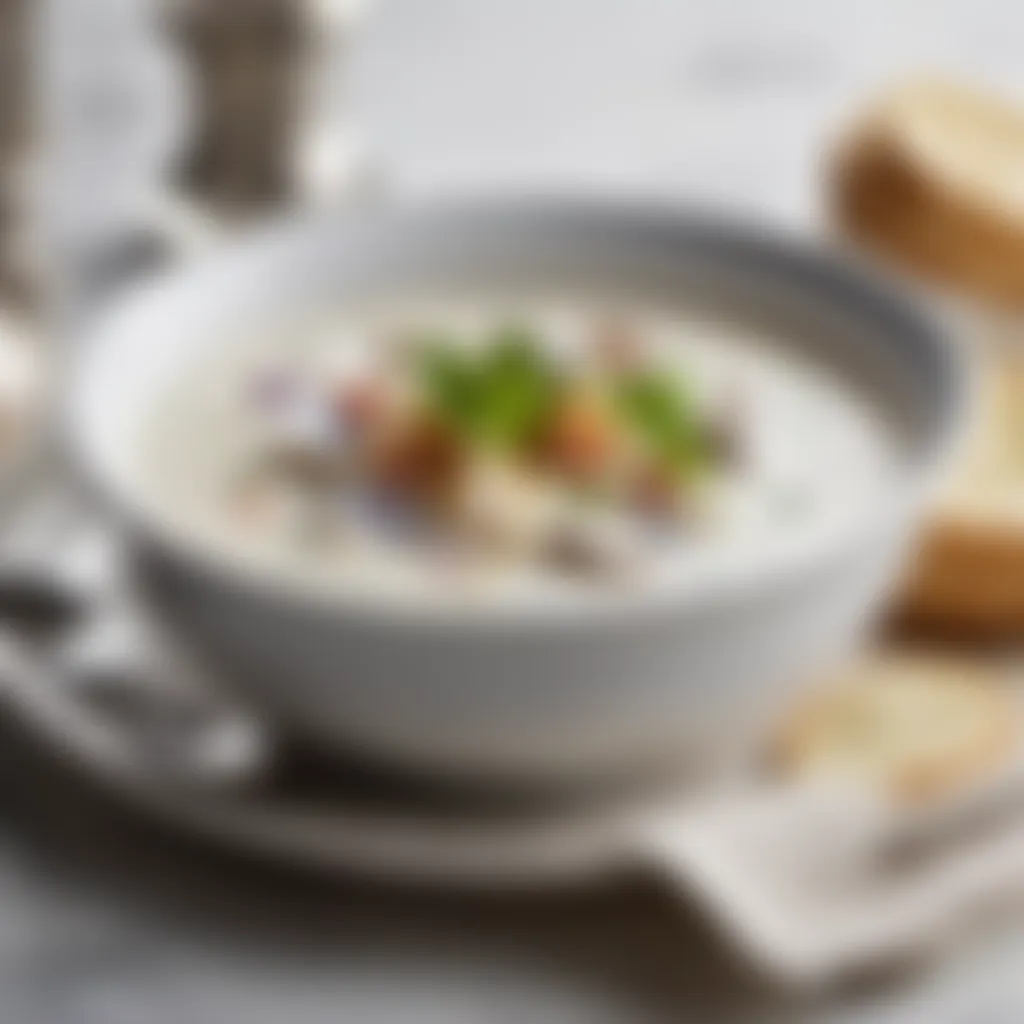
Troubleshooting Common Issues
Clam chowder, like any dish, can come with its own set of complications. Understanding how to tackle these snags is crucial for anyone trying to master this delightful cuisine. It’s not merely about following a recipe; it’s about recognizing potential pitfalls that could ruin the dish or at least impact your enjoyment of it. When you know how to troubleshoot common problems, you enhance both the quality of your chowder and your confidence as a home cook.
Flavor Imbalance
One of the most frequent issues home cooks face when preparing clam chowder is a flavor imbalance. This occurs when one or several flavors overshadow the others, making the dish either too salty, bland, or cloyingly sweet. Achieving a harmonious profile is essential; here are some suggestions to make sure every bite is a delight:
- Taste as You Go: Simple, yet powerful. Always sample your chowder as it simmers. This allows you to adjust seasonings in real-time.
- Salt Gradually: Adding salt in increments can prevent the chowder from becoming overly salty. It's easier to increase than to diminish.
- Acidity is Key: A dash of lemon juice or a splash of white wine can help cut through excessive richness without making it overly tart. Acid can be a great ally in balancing flavors.
- Sweetness Counteract: If you mistakenly added too much sweetness, incorporate a smidgen of salt or a dash of vinegar to counteract that sweetness. You might be surprised how just a bit of acid can bring everything back into line.
- Herb and Spice Adjustments: Fresh herbs like parsley or dill can bump up the freshness. If it seems flat, consider adding more aromatics slowly and carefully.
Always remember that cooking is a process of adjustments. Paying attention to the flavor profiles and making small tweaks can yield remarkably different results.
"A well-seasoned chowder takes time, attention, and a willingness to adapt."
Texture Concerns
Texture is another critical aspect that can make or break your clam chowder. A satisfying chowder should be creamy and smooth, yet still have that delightful bite from the clams and veggies. Here’s how you can avoid some common texture troubles:
- Overcooking Clams: This is a classic pitfall. Clams should be tender but not rubbery. Adding them later in the cooking process can help maintain a pleasant texture. Think of them as the finishing touch.
- Thickening Agents: If your chowder is too thin, you can employ a slurry of cornstarch and water or mash some of the potatoes to thicken the broth naturally. A good guide is to use about 1 tablespoon of cornstarch per cup of liquid, whisked until smooth.
- Grit or Graininess: If you notice a gritty texture, it often means the clams weren’t cleaned thoroughly. Always soak them in salted water before use. This encourages clams to expel sand.
- Dairy Addition Timing: Incorporate dairy products at the right time. If you add cream or milk too early, it may curdle or separate. Waiting until the end ensures a velvety finish.
In summary, maintaining the right texture involves timing and technique. By being attentive to your clams and the dairy additions, you can deliver a smooth and enjoyable dish every time.
Storing Clam Chowder
When it comes to clam chowder, enjoying it is only part of the experience. Proper storage plays a critical role in prolonging its freshness and flavors. Storing clam chowder correctly not only ensures that you can savor it later, but it also maintains the dish's integrity and safety. Whether you have leftovers after a cozy dinner or you’ve prepped a batch for future enjoyment, knowing how to store it is essential.
One main benefit of storing clam chowder is convenience. You can whip up a batch on the weekend and indulge in it throughout the week. Keeping the chowder fresh saves both time and effort. It becomes a lifesaver on busy days when cooking from scratch might seem like scaling Mount Everest. Additionally, this process allows the flavors to mature, often enhancing the taste when it's reheated.
However, there are some considerations to keep in mind. The creamy base of clam chowder can separate or curdle if not stored under the right conditions. That’s why proper technique is key. Below we cover some effective methods to help you keep that bowl of goodness as enjoyable later as it was when freshly made.
Reheating Techniques
When the moment comes to reheat your clam chowder, the goal is to bring it back to life while avoiding those dreaded lumps or a split texture. There are some tried and tested techniques to ensure that your chowder retains its luxurious creaminess without losing its charm.
- Stovetop Method:
- Microwave Method:
- Pour the desired amount of chowder into a saucepan.
- Gently heat it over low-medium heat.
- Stir frequently to ensure even heating.
- Add a splash of additional cream or broth if it seems too thick.
- Place the chowder in a microwave-safe container.
- Cover it loosely to allow steam to escape.
- Heat in intervals of 30 seconds, stirring between each interval until reaching your desired temperature.
Always remember that clam chowder is best enjoyed warm but not boiling. Too high of a temperature can ruin that smooth finish, and nobody wants to bite into chunky chowder!
Freezing for Later Use
Freezing clam chowder can be an excellent way to preserve it for an extended period. However, note that not all clam chowder recipes fare well in the freezer due to the cream content. Here’s how to freeze it so that you can capture its delightful flavors:
- Cool It Down: Before putting chowder in the freezer, allow it to cool completely at room temperature. This step prevents condensation, which could lead to ice crystals forming.
- Use Appropriate Containers: Place the chowder in airtight containers or freezer bags, leaving some space for expansion. Remember, filling them to the brim can lead to food explosions in your freezer!
- Label: Don’t forget to label the containers clearly. Include the date and contents for easy reference when it’s time to grab a bowl for those chilly evenings.
- Freezing Period: Most clam chowder can stay in the freezer for up to three months without losing significant quality. Beyond that, the flavors might fade, so try to keep an eye on your inventory.
"Proper storage allows you to hold onto the heartfelt flavors of your chowder, making every bowl a comforting throwback to when it was freshly made."
By following these steps to store and reheat your clam chowder, you’ll ensure every bite is just as comforting as the first ladleful.
Epilogue: The Essence of Mastery in Clam Chowder
As we bring this guide to a close, it’s time to reflect on what mastery of clam chowder truly means. It’s not just the act of following a recipe verbatim; it’s about understanding the heart and soul of the dish. Mastery over clam chowder lies in the artful balance of flavors, the careful selection of premium ingredients, and the personal touch you imbue into every serving. When you elevate this dish from mere sustenance to a heartfelt culinary experience, you begin to appreciate the layered nuances that make clam chowder a beloved classic.
In preparing clam chowder, there are many factors to consider—your choice of clams, aromatics, and even the type of cream or milk can all have profound implications on the final result. Each bowl tells a story; it's a reflection of your culinary journey, one that may evolve with every spoonful you savor. Think of it as a canvas. You are the artist, painting with flavors, forming a dish that is uniquely your own.
"Culinary mastery is about understanding, creativity, and passion—immerse yourself in the process."
Mastering clam chowder doesn't stop with making it once; it's a continual process of exploration and refinement as you strive to create that perfect blend that brings comfort to the table.
Reflections on the Culinary Journey
Navigating the journey of perfecting clam chowder can be likened to an exploration marked by triumphs and lessons learned. As one delves into the layers of this classic dish, it becomes clear that the experience transcends the dish itself.
There is something grounding in the act of cooking, particularly when preparing a dish as rich in history as clam chowder. You develop a deeper appreciation for the nuances of flavor and texture. Perhaps it starts with a special family recipe. Each time you recreate it, you reflect on the memories it holds. Or maybe you begin experimenting with modern twists, integrating flavours from different cuisines. This dance with tradition and innovation only deepens your relationship with clam chowder.
Your culinary journey is a reflection not only of your skills but of your heritage and culture. It connects you with those who have shared the table with you over the years. Therefore, each effort contributes to a broader narrative about comfort food and connection.
Continuing the Exploration of Clam Chowder
Clam chowder is not a dish to be confined to a single recipe or manner of preparation. Its potential is practically limitless, offering a variety of avenues for continued exploration. Whether you seek to refine techniques, discover new flavor combinations, or cater a version that aligns with dietary needs, the adventure is ever-present.
Consider diving into other regional variations beyond the familiar New England and Manhattan styles. The depth of clam chowder can vary significantly depending on its geographical roots and cultural influences.
Some avenues you might explore include:
- Experimenting with New Ingredients: Think beyond traditional clams; try adding different shellfish or even fish to create delightful surprises in texture and flavor.
- Infusing Global Flavors: Introduce spices like cumin or chili to enhance the heat, or use coconut milk for a tropical twist. The world is your oyster—pun intended!
- Embracing Technology: Explore new gadgets like the Instant Pot or sous vide method to change how you prepare chowder, maintaining its essence while re-inventing the process.
Ultimately, clam chowder serves more than just being a delicious meal; it evokes memories and creates new ones. As you continue to tinker with ingredients and techniques, you’ll not only master the dish but also keep alive the spirit of exploration that makes cooking both a craft and an art.







